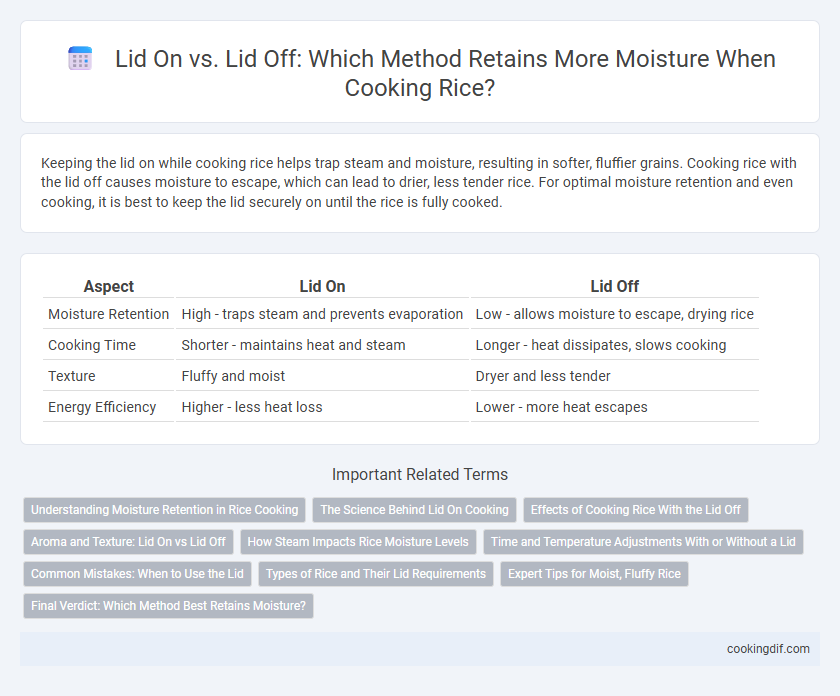Keeping the lid on while cooking rice helps trap steam and moisture, resulting in softer, fluffier grains. Cooking rice with the lid off causes moisture to escape, which can lead to drier, less tender rice. For optimal moisture retention and even cooking, it is best to keep the lid securely on until the rice is fully cooked.
Table of Comparison
| Aspect | Lid On | Lid Off |
|---|---|---|
| Moisture Retention | High - traps steam and prevents evaporation | Low - allows moisture to escape, drying rice |
| Cooking Time | Shorter - maintains heat and steam | Longer - heat dissipates, slows cooking |
| Texture | Fluffy and moist | Dryer and less tender |
| Energy Efficiency | Higher - less heat loss | Lower - more heat escapes |
Understanding Moisture Retention in Rice Cooking
Lid on cooking traps steam, creating a sealed environment that helps retain moisture and ensures fluffy, evenly cooked rice. Leaving the lid off allows steam to escape, leading to drier rice and potential uneven cooking due to moisture loss. Understanding the role of lid use is crucial for optimizing rice texture and preventing undercooking or drying out during the steaming process.
The Science Behind Lid On Cooking
Cooking rice with the lid on traps steam, creating a consistent, high-humidity environment that facilitates even moisture absorption and prevents water evaporation. The trapped steam gelatinizes the rice starches more effectively, resulting in a tender, fully cooked texture with optimal moisture retention. Heat transfer is more efficient under the lid, maintaining a stable temperature that enhances the rice's flavor and nutritional profile by preserving water-soluble vitamins.
Effects of Cooking Rice With the Lid Off
Cooking rice with the lid off causes more moisture to evaporate, resulting in drier, less tender grains. This method enhances the rice's texture by preventing excessive stickiness and allows better control over cooking by visually monitoring water absorption. As a result, lid-off cooking is preferred for achieving fluffy rice with distinct grains, particularly in varieties like basmati or jasmine.
Aroma and Texture: Lid On vs Lid Off
Cooking rice with the lid on traps steam, enhancing moisture retention and preserving the rice's natural aroma, resulting in a tender texture. Leaving the lid off allows moisture to escape, which can lead to drier grains and a less pronounced fragrance. For optimal aroma and a soft, fluffy texture, keeping the lid on throughout the cooking process is recommended.
How Steam Impacts Rice Moisture Levels
Keeping the lid on while cooking rice traps steam, thereby increasing moisture retention and resulting in fluffy, tender grains. Steam circulates within the pot, evenly hydrating the rice and preventing dryness by maintaining a consistent temperature and moisture level. Conversely, cooking with the lid off allows steam to escape, leading to drier rice and uneven texture due to reduced moisture retention.
Time and Temperature Adjustments With or Without a Lid
Cooking rice with the lid on traps steam, promoting even moisture retention and reducing cooking time by maintaining a consistent temperature around 212degF (100degC). Removing the lid requires lower heat and extended cooking time to prevent water evaporation and ensure the rice absorbs enough moisture without drying out. Optimal rice texture depends on balancing time and temperature adjustments based on whether the lid is used to control steam and moisture levels.
Common Mistakes: When to Use the Lid
Leaving the lid off during cooking rice often causes excessive moisture loss, resulting in dry, unevenly cooked grains. A common mistake is removing the lid too early, which disrupts the steam trap essential for proper absorption and texture. Using a tightly sealed lid ensures optimal moisture retention, yielding fluffy, perfectly cooked rice every time.
Types of Rice and Their Lid Requirements
Short-grain rice such as sushi or arborio retains moisture best with the lid on, promoting even cooking and preventing steam loss. Long-grain varieties like basmati and jasmine benefit from a lid-off method during initial cooking phases to allow excess moisture to evaporate, achieving fluffy, separate grains. Sticky rice and glutinous types require consistent steam retention with the lid tightly closed to maintain their characteristic texture and prevent drying.
Expert Tips for Moist, Fluffy Rice
Keeping the lid on during rice cooking traps steam and prevents moisture loss, resulting in tender, fluffy grains. Experts recommend simmering rice with the lid tightly sealed to maintain optimal moisture levels and avoid dryness. For perfectly cooked rice, allow it to rest covered off heat, enabling even moisture distribution and enhanced texture.
Final Verdict: Which Method Best Retains Moisture?
Cooking rice with the lid on effectively traps steam and moisture, resulting in softer, fluffier grains with higher moisture retention. Leaving the lid off during cooking allows excess moisture to evaporate, often producing drier rice with a firmer texture. For optimal moisture retention and taste, the lid-on method is preferred in most rice cooking techniques.
Lid on vs Lid off for moisture retention Infographic

 cookingdif.com
cookingdif.com